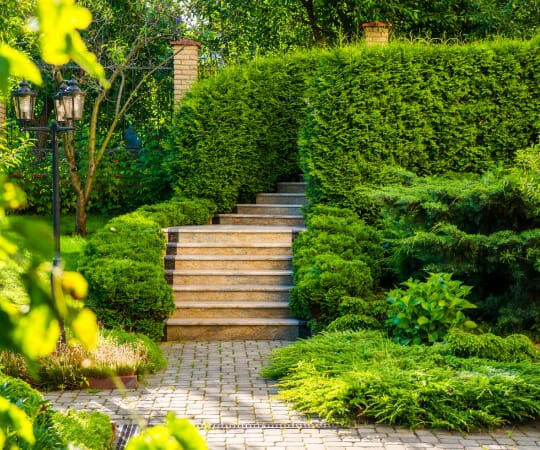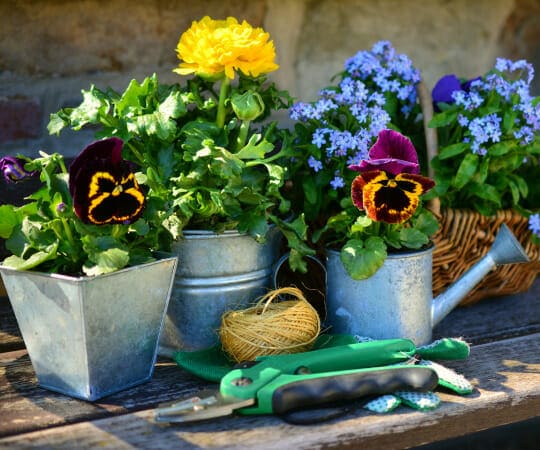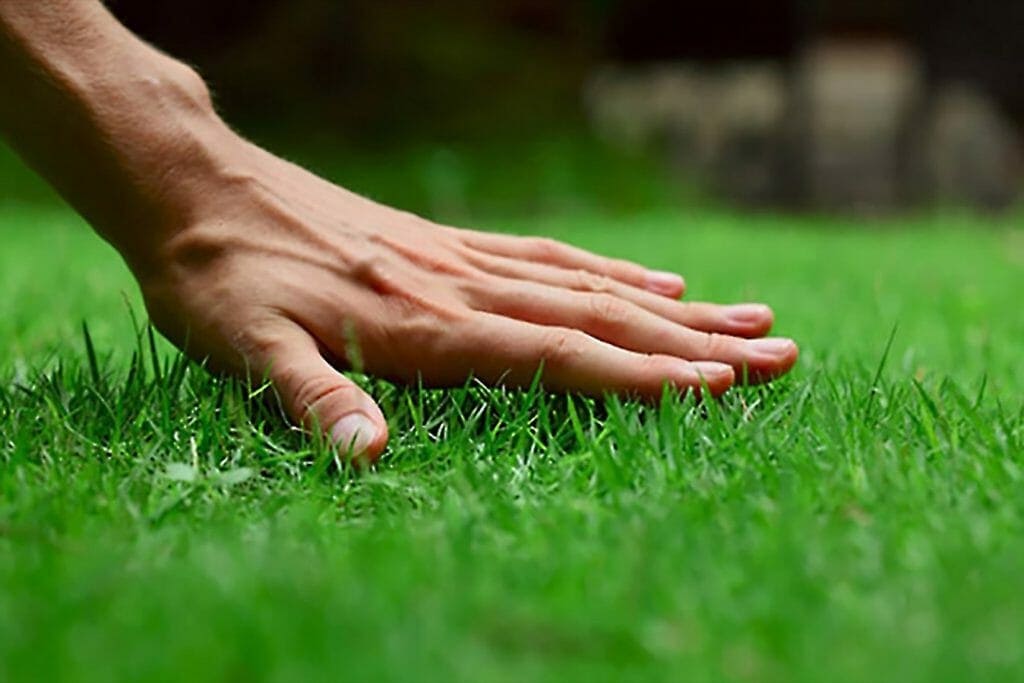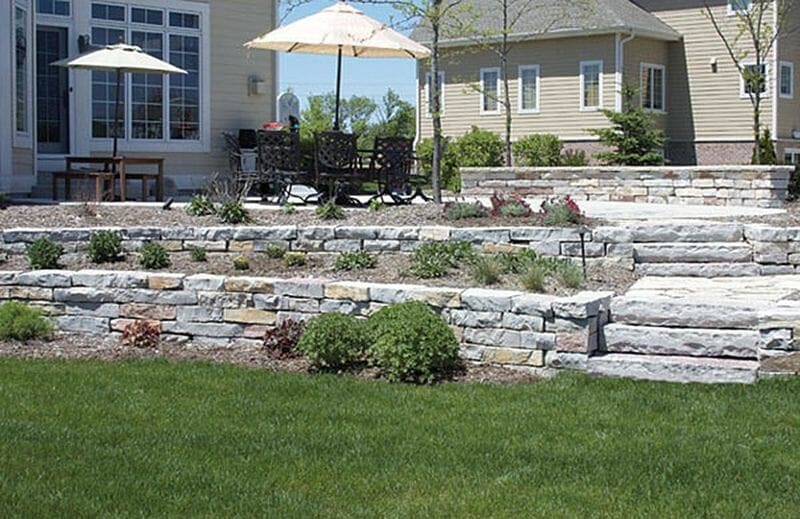Discover the Magic of Eco-Friendly Landscaping: Transform Your Outdoor Space into a Sustainable Oasis
Are you tired of the sterile, manicured lawns that dominate suburban neighborhoods? Do you long for a deeper connection with nature and a landscape that sustains itself without harmful chemicals and excessive maintenance? The answer lies in embracing nature’s harmony and crafting a sustainable landscape brimming with eco-friendly marvels.
Creating a sustainable landscape is not only environmentally responsible but also aesthetically pleasing. By incorporating native plants, wildlife habitats, and sustainable practices, you can transform your outdoor space into a vibrant ecosystem that supports biodiversity and promotes ecological balance.
Not only will this benefit the environment, but it will also provide you with a peaceful retreat where you can connect with nature and recharge your spirit. So let’s dive into the world of sustainable landscaping and discover how to create an outdoor oasis that harmonizes with the natural world.
Assess Your Environment
You’ll want to start by taking a close look at your surroundings in order to determine what changes can be made for a more environmentally-conscious outdoor space. Assessing your environment is crucial in understanding the current state of your landscape and its environmental impact.
This will help you identify areas where resource management can be improved, such as reducing water usage or minimizing chemical fertilizers. By assessing your environment, you can also determine which plants are best suited for your area.
Choosing native plants that thrive in your region not only reduces maintenance but also supports local ecosystems. With this knowledge, you can begin crafting a sustainable landscape that embraces nature’s harmony and promotes eco-friendly marvels.
Choose Native Plants
Opting for plants that are indigenous to your area is a smart move for creating a low-maintenance and eco-conscious outdoor space. Not only do native plants thrive in their natural environment, but they also require less watering and maintenance than non-native species.
Additionally, native plants provide habitat and food sources for local wildlife, contributing to a healthy ecosystem. When selecting the right native plants for your area, consider factors such as soil type, sun exposure, and moisture levels.
Research which species are best suited for your region and aim to incorporate a variety of colors and textures into your landscape design. By choosing native plants over exotic species, you’ll not only reduce the use of harmful pesticides and fertilizers but also promote biodiversity in your community.
Incorporating sustainable practices into your landscape design doesn’t have to be difficult or time-consuming. With the right mindset and knowledge, you can create an outdoor space that is both beautiful and environmentally friendly.

Incorporate Sustainable Practices
You’re on your way to creating a sustainable landscape by incorporating sustainable practices.
Let’s start with rainwater harvesting, which involves collecting and storing rainwater for future use in watering plants or cleaning.
Composting is also an essential practice that turns organic waste into nutrient-rich soil, reducing waste and improving soil health.
Finally, using organic fertilizers instead of chemical ones promotes healthier plant growth while avoiding harmful chemicals that can harm the environment.
Rainwater Harvesting
As we collect rainwater, we can create a cycle of replenishment, nourishing our surroundings with the precious resource that nature provides. Rainwater harvesting is an eco-friendly practice that has been used for centuries, and it’s still relevant today.
By collecting rainwater, we reduce the demand on municipal water supplies and lower our utility bills. DIY installations are becoming increasingly popular for urban applications as more people become aware of the benefits of rainwater harvesting.
With simple equipment like gutters and storage tanks, you can collect enough water to irrigate your garden or even use it in your home for non-potable uses like flushing toilets or doing laundry. Rainwater harvesting is a simple yet effective way to conserve resources and improve sustainability.
Speaking of conserving resources, let’s move on to the next topic: composting.
Composting
Get ready to turn your food waste into nutrient-rich soil that will help your plants thrive and reduce greenhouse gas emissions by composting.
Composting is the process of breaking down organic waste, such as food scraps, leaves, and grass clippings, into a rich soil amendment. By diverting these materials from landfills, you can reduce methane emissions, which are harmful greenhouse gases that contribute to climate change.
Not only does composting benefit the environment, but it also benefits your garden. Compost adds nutrients to the soil and improves its structure and water-holding capacity. Plus, it promotes healthy microbial activity in the soil which can boost plant growth and deter pests and diseases.
And don’t worry if you don’t have a lot of space or money – there are plenty of DIY compost bin options available for any sized yard or budget. So start composting today and watch your garden flourish!
As you embrace eco-friendly practices in your landscape design, consider using organic fertilizers as an alternative to synthetic ones.
Using Organic Fertilizers
You’ll love using organic fertilizers to nourish your plants and reduce harm to the environment. Unlike chemical fertilizers, which can damage soil health and pollute waterways, organic fertilizers are made from natural sources like compost, manure, and bone meal.
Not only do they provide essential nutrients for your plants, but they also improve soil structure and promote beneficial microorganisms that help fight off pests and diseases. Plus, organic fertilizers release their nutrients slowly over time, so there’s less risk of burning your plants or causing excess growth.
The benefits of organic fertilizers go beyond just improving plant health. By choosing eco-friendly alternatives to chemical fertilizers, you’re taking an active role in protecting the environment. Chemical fertilizers can leach into groundwater or runoff into nearby streams and rivers, harming aquatic life and contributing to pollution.
Organic fertilizers are a more sustainable choice that support healthy ecosystems without compromising on results. So why not give them a try? Your plants – and the planet – will thank you.
As you move on to creating wildlife habitats in your sustainable landscape, keep in mind how your choice of fertilizer can impact the animals who call it home. By using organic options instead of harsh chemicals, you’ll be providing a healthier environment for all creatures great and small.
Create Wildlife Habitats
If you’re looking to enhance the natural beauty of your landscape, creating wildlife habitats is a great way to do it. Not only does this practice support local ecosystems and biodiversity, but it also allows you to observe and appreciate the diverse range of creatures that call your area home.
Incorporating birdhouses and feeders can attract feathered friends like chickadees, blue jays, and finches. Building a bee-friendly garden can promote pollinator populations and help sustain our food supply.
Benefits of Supporting Local Wildlife
Encouraging the presence of local wildlife in your outdoor space not only benefits the environment, but also adds a sense of natural beauty and complexity to your surroundings. When you attract pollinators like bees and butterflies, you’re helping to ensure that plants can reproduce and thrive. This, in turn, supports biodiversity by providing habitats for other creatures such as birds and small mammals.
By creating a welcoming environment for local wildlife, you’re doing your part in preserving the delicate balance of nature. But there are also benefits for you personally. Watching birds at a feeder or seeing a colorful butterfly flit by can bring joy and relaxation to your day. It can also be educational for children who may learn about different species and their behaviors through observation.
So when planning your sustainable landscape, consider incorporating features like native plants that attract pollinators or leaving areas of natural habitat untouched. Supporting local wildlife is not only good for the planet, but it can enhance your own connection to nature as well.
By incorporating birdhouses and feeders into your outdoor space, you can continue to support local wildlife while adding even more beauty to your surroundings. These structures provide shelter and food sources for birds throughout the year, including during times when natural food sources may be scarce. In addition to attracting songbirds with feeders filled with seeds or nectar, installing birdhouses allows cavity-nesting species like bluebirds or chickadees to raise their young safely away from predators. Allowing these feathered friends to reside in your backyard creates another layer of interest and wonderment in an already vibrant ecosystem.
Incorporating Birdhouses and Feeders
To attract and accommodate avian amigos, add birdhouses and feeders to your backyard for a beautiful and bustling bird haven. DIY birdhouses can be made from recycled materials such as old wood or metal scraps. These DIY projects not only provide shelter for birds but also add a unique touch to your garden.
When it comes to bird feeder placement, make sure they are placed in areas that are visible but also safe from predators such as cats. Additionally, consider placing feeders near shrubs or trees where birds can perch before approaching the feeder.
By incorporating birdhouses and feeders into your sustainable landscape, you not only create a welcoming environment for feathered friends but also support local wildlife.
However, attracting birds isn’t the only way to enhance your eco-friendly garden. Next up is building a bee-friendly garden by planting native flowers and herbs that attract pollinators like bees!
Building a Bee-Friendly Garden
Now that you’ve learned how to attract beautiful birds into your garden with birdhouses and feeders, it’s time to focus on another important creature: bees. Building a bee-friendly garden not only adds color and beauty to your outdoor space, but it also benefits the environment in many ways.
By providing bees with a habitat and food source, you’re helping them play their crucial role as pollinators. This helps ensure the production of fruits, vegetables, and flowers for people and other animals alike. Plus, beekeeping benefits extend beyond just honey production – they can also serve as educational tools for children and adults alike to learn about sustainability practices and pollinator partnerships.
To get started on creating a bee-friendly garden, consider these tips:
- Choose native plants that are rich in pollen or nectar
- Provide nesting sites such as hollow stems or bee hotels
- Avoid pesticide use which can harm bees
- Consider adding a water source like a birdbath or shallow dish
With these simple steps, you can create an environment that supports local pollinators while enjoying the sights and sounds of buzzing bees in action. So why not add some buzz to your backyard with a bee-friendly garden?
As you continue crafting your sustainable landscape filled with eco-friendly marvels such as birdhouses, feeders, and now a bee-friendly garden, it’s important to think about maintenance and long-term sustainability.

Maintenance and Long-Term Sustainability
Maintaining a landscape that supports long-term sustainability requires ongoing effort and a commitment to environmentally conscious practices. It’s not enough to simply build an eco-friendly garden; you must also ensure that it remains sustainable in the years to come.
One of the best ways to do this is through cost-effective solutions that reduce your environmental impact. Regular maintenance is essential for keeping your eco-friendly garden healthy and thriving. This includes tasks such as watering, weeding, pruning, and fertilizing.
However, it’s important to approach these tasks in an environmentally conscious way. For example, you can use rain barrels or drip irrigation systems to conserve water, compost yard waste instead of throwing it away, and choose organic fertilizers that don’t harm beneficial insects or pollute groundwater.
By making small but consistent efforts towards sustainable maintenance practices, you can enjoy a beautiful and eco-friendly landscape for years to come.
Frequently Asked Questions
How do I create a sustainable landscape on a limited budget?
Creating a sustainable landscape on a limited budget can seem daunting, but with some tips and tricks, it’s definitely achievable! DIY eco-friendly landscaping ideas are a great place to start.
Consider using native plants that require less maintenance and water, or even creating your own compost from food scraps to use as fertilizer. Using mulch around plants can also help retain moisture in the soil and reduce the need for watering.
Don’t forget about rain barrels to collect water for irrigation. With a little creativity and research, you can create a beautiful and sustainable landscape without breaking the bank.
Can I incorporate non-native plants into my sustainable landscape?
Did you know that non-native plants make up over one-third of all plant species in the United States?
While some argue that incorporating non-native plants into your sustainable landscape can add diversity and beauty, others believe that it disrupts the delicate balance of the local ecosystem. Non-native plants often outcompete native species for resources, leading to a decline in biodiversity and potentially harming wildlife.
It’s important to carefully consider the impact of introducing non-native plants before making any decisions for your sustainable landscape. As an eco-conscious individual, you can embrace nature’s harmony by prioritizing native plant species and creating a space that supports the local ecosystem.
How do I attract specific types of wildlife to my habitat?
If you’re looking to attract specific types of wildlife to your sustainable landscape, there are a few things you can do.
Creating wildlife friendly features like birdhouses, bat boxes, or pollinator gardens can provide habitat for various species.
It’s important to also balance human needs with wildlife needs, so consider incorporating elements like water features or native plants that serve both purposes.
Additionally, minimizing pesticide use and providing food sources can help support the ecosystem in your backyard.
By taking these steps, you’ll not only create an inviting space for wildlife but contribute to a healthier and more balanced environment overall.
What are some common mistakes people make when trying to create a sustainable landscape?
When attempting to create a sustainable landscape, there are a few common mistakes that people tend to make. One of these is poor compost management.
While composting can be an excellent way to reduce waste and nourish your soil, it’s important to do it correctly. Be sure to balance your greens and browns, turn the pile regularly, and keep it moist but not too wet.
Another mistake is failing to use energy-efficient lighting. This can result in wasted electricity and harm the environment unnecessarily. Consider using LED or CFL bulbs instead of incandescent ones, and be sure to turn off lights when they’re not needed.
By avoiding these mistakes and taking other eco-conscious steps, you can create a beautiful landscape that’s both attractive and environmentally friendly.
Is it necessary to hire a professional landscaper to create a sustainable landscape?
When it comes to creating a sustainable landscape, you may be wondering if it’s necessary to hire a professional landscaper or if you can tackle the project on your own.
There are pros and cons to both options. If you choose to go the DIY route, you have more control over the design and implementation of your landscape. However, this also means that you are solely responsible for ensuring that everything is done correctly and in an eco-friendly manner.
On the other hand, hiring a professional landscaper can take some of the stress off of you and ensure that your landscape is expertly designed and installed with sustainability in mind. However, this option can also come with a higher cost.
Ultimately, whether you choose to go DIY or hire a professional will depend on your budget, time constraints, and level of expertise in landscaping.
Conclusion
Now that you’ve learned about the importance of creating a sustainable landscape, it’s time to take action and embrace nature’s harmony. By assessing your environment and choosing native plants, you can create a thriving ecosystem that benefits both the environment and the wildlife around you.
Incorporating sustainable practices into your landscape design can also help reduce waste and preserve natural resources. Creating wildlife habitats, such as bird feeders or butterfly gardens, adds beauty and diversity to your surroundings while providing a safe haven for local animals.
As you continue to maintain your eco-friendly landscape, remember to prioritize long-term sustainability by using organic fertilizers and limiting water usage. By embracing these practices, you can create a beautiful outdoor space that not only benefits the planet but also provides a sense of peace and tranquility for yourself.
So go ahead, let nature inspire you as you craft an eco-friendly marvel in your own backyard!
Related Sources
Sustainable Landscaping: Embracing Eco-Friendly Practices for a Greener Yard



